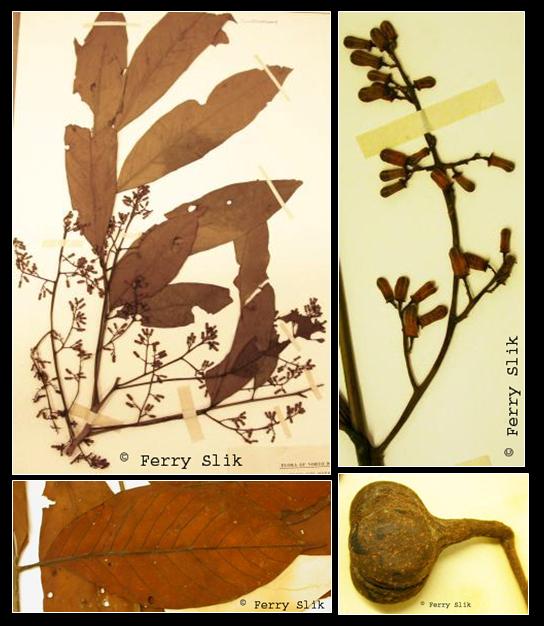Dysoxylum alliaceum (Blume) Blume, Bijdr. (1825)
Latin for 'onion-like', referring to the smell of the wood.Synonyms
Aglaia oligosperma (Pierre) Pellegr.
Alliaria acuminatissima (Blume) Kuntze
Alliaria costulata (Miq.) Kuntze
Alliaria fraterna (Miq.) Kuntze
Alliaria glabra (C.DC.) Kuntze
Alliaria lamponga (Miq.) Kuntze
Alliaria miqueliana (C.DC.) Kuntze
Alliaria nageliana (C.DC.) Kuntze
Alliaria similis (Blume) Kuntze
Alliaria thyrsoidea (Hiern) Kuntze
Alliaria vrieseana (C.DC.) Kuntze
Amoora oligosperma Pierre
Chisocheton dempoense Baker.f.
Dysoxylum aculeatissimum Steud.
Dysoxylum acuminatissimum Blume
Dysoxylum alliaceum var. angustifolium Valet.
Dysoxylum alliaceum var. genuinum Valet.
Dysoxylum alliaceum var. lanceolatum Koord. & Valet.
Dysoxylum alliaceum var. laxiflorum (Blume) C.DC.
Dysoxylum alliaceum var. pauciflorum Koord. & Valet.
Dysoxylum apoense Elmer
Dysoxylum archboldianum Merr. & L.M.Perry
Dysoxylum brachycalcyninum Harms
Dysoxylum brevipes Hiern
Dysoxylum costulatum (Miq.) Miq.
Dysoxylum dempoense (Baker.f.) Harms
Dysoxylum euphlebium Merr.
Dysoxylum excelsum var. glabriflorum Miq.
Dysoxylum fraternum Miq.
Dysoxylum glabrum C.DC.
Dysoxylum klemmei Merr.
Dysoxylum lampongum Miq.
Dysoxylum lanceolatum Elmer
Dysoxylum laxiflorum Blume
Dysoxylum longifolium Blume
Dysoxylum macrothyrsum Miq. [Illegitimate]
Dysoxylum miquelianum C.DC.
Dysoxylum monticola Harms
Dysoxylum nagelianum C.DC.
Dysoxylum platyphyllum Merr.
Dysoxylum pulchrum Ridl.
Dysoxylum rostratum Merr.
Dysoxylum sattelbergense Merr. & L.M.Perry
Dysoxylum simile Blume
Dysoxylum thyrsoideum Hiern
Dysoxylum thyrsoideum var. andamanicum King
Dysoxylum vrieseanum C.DC.
Guarea alliacea Blume
Guarea axillaris Blume
Guarea foetida Blume
Hartighsea costulata Miq.
Prasoxylon alliaceum (Blume) M.Roem.
Trichilia similis (Blume) Spreng.
Diagnostics
All parts smell strongly of onion, which is a nice character for this species.
Mid-canopy tree up to 38 m tall and 80 cm dbh. Stipules absent. Leaves
alternate, compound, leaflets penni-veined, glabrous. Flowers ca. 7 mm diameter,
white-yellowish, placed in panicles. Fruits ca. 20 mm diameter, white-pink-red,
capsules. Seeds without aril.
Description
Tree to 38 m, often of poor form; bole to 80 cm diam., fluted to c. 4 m with buttresses
to 60 cm tall and 1 m out. Bark thin, lenticellate to finely fissured and shedding irregular
strips; inner bark red-brown, yellower within, usually with strong smell of onions: sapwood
fawnish; heartwood red-brown. Twigs cicatrose, striate, elenticellate. Leafy twigs
c. 5-8 mm diam.; apical buds with list-shaped young leaves, +/- pubescent. Leaves to
60(-l20) cm, usually smelling of onions when crushed, 3-6(-8)-jugate, subglabrous,
subcoriaceous, petiole 5-15 cm, flattened adaxially, weakly swollen at base. Leaflets
7.5-25 by 2.5-7.5 cm, elliptic or ovate, or subfalcate, opposite to subopposite with an
apical pair or one of these appearing terminal and with a small apical scar, shiny dark
green adaxially, bases +/- asymmetric, apices acuminate, nerves 8-12(-14) on each side,
arcuate, subprominent abaxially; peliolules 5-20 mm, sulcate. Thyrses to 40 cm, pyramidal,
proximal branches 8-20 cm with branchlets to 5 cm, bearing cymules of 1-3
sweetly scented flowers; axes puberulous; bracts and bracteoles minute. Flowerbuds
with truncate apices, oblong; pedicels 2.5-4 mm long. Calyx c. 2.5-3 mm diam., shallowly
cupular or salveriform, glabrous to subpuberulous without, margin 4-toothed.
Petals 4 or 5, 5-8 mm long, linear, valvate, glabrous or pubescent within, white, or
pinkish, drying black. Staminal tube glabrous or puberulous without, +/- hairy within,
margin subtruncate to 8- (or 10-)denticulate; anthers 8 (10), c. 1 mm long, included.
Disk c. 1 mm tall, +/- pubescent on both sides, truncate to obscurely lobed, margin ciliate.
Ovary glabrous to hirsute, 3-locular, each locule 2-ovulate, style terete; stylehead
subdiscoid, +/- dimpled. Infructescence +/- branched, to 25 cm long. Capsule to 7.5 cm
diam., subglobose or lobed and constricted between seeds or beaked, occasionally
markedly so (the beak to 15 mm) when 1-seeded, greenish white when unripe, red at
maturity, drying black. Seeds 1-4 per capsule; oblong-globose, testa red, exarillate,
when cut producing white latex and usually strong smell of onions; cotyledons superposed
to collateral. [from Flora Malesiana]
Ecology
In undisturbed mixed dipterocarp forests up to 1800 m altitude. On hillsides
and ridges with sandy soils, but also on limestone.
Uses
All parts smell strongly of onions. Fresh young leaves are cooked with fish or other food to
impart an onion flavour. The seeds in particular are used together with some juice of ginger
and lemon or lime, to prepare a sauce very similar to garlic sauce, which is served with fish
and other food. In the past, dried seeds that were blackened from being dried in smoke, were
taken on ships as a garlic substitute. The wood is white and light; it is used on a small scale
for interior construction but is not insect-resistant.
Distribution
Peninsular Thailand and Andaman Islands to the Solomon Islands and Australia. Possibly occurring also
in South Vietnam.
Local names
Borneo: Kambutong, Langsat-langsat, Langsat munyit, Latak manuk, Longkang bawang, Marburung,
Sibaumater bau.
Java: Ki Bawang (Sundanese), Pela (Javanese), Pingku.
Malaysia: Beka-beka bukit, Kasai tembaga, Kulim, Kulim burong.
Moluccas: Kayu bawang.
Philippines: Kalimutain, Kuling-babui (Tagalog), Paluahan (Bisaya).
Sumatra: Ki bawang.
Thailand: Ta suea khao (peninsular).
Vietnam: ch[awj]c kh[ees].
